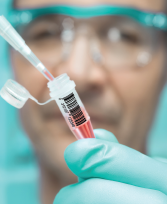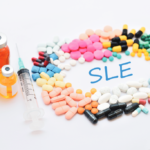
anyaivanova / shutterstock.com
A new biologic agent for treatment of systemic lupus erythematosus (SLE) being tested in clinical trials is showing promise as a safe and effective new treatment, particularly in patients with more severe disease or serologically active disease.
Recently published results of a study that examined the safety and efficacy of atacicept for SLE showed the biologic agent reduced disease activity and severe flares and was well tolerated.1
“The results reported in this paper provide hope that atacicept may have meaningful benefits for lupus patients,” says lead author, Joan T. Merrill, MD, of the Arthritis & Clinical Immunology Program at the Oklahoma Medical Research Association Oklahoma City. “And [it] seems to be safe and well tolerated when reasonable clinical safety measures are used.”
However, Dr. Merrill stresses that more study is needed because the trial did not meet its primary outcome measure. The main benefits seen in the study were in a subgroup of patients with more severe disease and/or serological activity.

Dr. Merrill
Given the complexity of lupus and the fluctuating nature of the disease, Dr. Merrill, who is also the chief advisor for clinical development for the Lupus Foundation of America, underscored that determining the best outcome measures to assess new treatments for lupus is an ongoing issue. “There are a lot of potential issues in interpreting the results of clinical trials in this disease,” she says.
Although the primary outcome measure of the study was not met, Dr. Merrill says the benefits in the subgroup of patients with more severe or serologically active disease confirms a pattern seen in other lupus trials, which have found greater differences between effective treatments and placebo when a more ill subset of patients is tested.
ADDRESS II: A Look at the Study
The ADDRESS II study was a phase 2b, multicenter, randomized, double-blind, placebo-controlled trial that tested the efficacy and safety of atacicept in patients with active lupus. Atacicept, a biologic agent that interferes with activation signals between T cells and B cells (subsets of white blood cells), was shown to reduce total B cell, plasma cell, and serum immunoglobulin levels in SLE patients in a previous study.2,3 It is seen as a potential therapeutic agent for lupus given that activated B cells are a classic feature of the disease.
A total of 306 patients were enrolled in the study and randomized to one of three treatment groups for 24 weeks: atacicept 75 mg (n=102), atacicept 150 mg (n=104), or placebo (n=100).
All patients were 18 years old or older, with at least moderately active, autoantibody-positive SLE, and were on standard therapy prior to randomization. Patients were excluded if they had received other investigational agents within the previous three months or if they had received belimumab, rituximab, ocrelizumab or other B cell-directed biologic therapies within one year of the study.
The primary outcome measure was the SLE Responder Index 4 (SRI-4) at Week 24 compared with the screening visit in the intent-to-treat (ITT) population (n=306). Secondary outcomes included reduction in corticosteroid dose and the patient’s global assessment of change at 24 weeks. The study also explored SRI-4 in subgroups of patients.
Efficacy: In the ITT population, the study found no statistically significant differences in SRI-4 between the treatment groups and placebo, although a trend in improved SRI-4 response rate was seen with atacicept at both doses. At 24 weeks, the SRI-4 response rate was 57.8% (adjusted odds ratio [OR] of 1.78 [95% CI 1.01-3.12]) for patients treated with atacicept 75 mg and 53.8% (OR of 1.56 [95% CI 0.89-2.72]) for those treated with atacicept 150 mg versus 44% for placebo (P=0.121).
Looking at secondary outcomes, the study also did not find any significant differences between atacicept at 75 mg or 150 mg and placebo in the proportion of patients achieving a reduction in corticosteroid dosage. In patients taking corticosteroid dosage of >10 mg/day at screening (baseline), 17.9% and 11.3% of patients treated with atacicept at 75 mg and 150 mg, respectively, had a dose reduction of <76.5 mg/day at 24 weeks compared with 18.9% of placebo patients.
In addition, no significant differences were noted between the treatment and placebo groups in changes in the patients’ global assessment at 24 weeks.
The study did find more patients in the ITT group receiving atacicept at either dose achieved an SRI-4 response compared with placebo (P<0.05 for each treatment dosage to placebo) based on a prespecified sensitivity analysis in which investigators looked at SRI-4 response at 24 weeks compared with the first day of the study as the baseline instead of the screening visit.
Safety: Atacicept was shown to be safe and well tolerated in the study. Treatment-emergent adverse events (TEAEs) with atacicept at 75 mg and 150 mg were seen in 81.4% and 80.8% of patients (vs. 72.0% in the placebo group). Among the TEAEs reported were upper respiratory tract infections and diarrhea (more common in the atacicept groups) and urinary tract infections (slightly more common in the placebo group).
Noting that atacicept may be a potent immunosuppressant and some serious infections and deaths have been reported in the past, Dr. Merrill emphasizes the current study guarded against the risk for serious infections by requiring all patients be up to date on their vaccinations. “Also, blood tests for levels of protective antibodies (immunoglobulins) were followed to mitigate the risk for infection during the study,” she says. Serious infections occurred in 1% of patients treated with atacicept 150 mg, 5.9% at 75 mg, and 5.0% with placebo. There were no deaths in this study.
Benefits
In exploratory analyses assessing SRI-4 in subgroups of patients, the study found a significant benefit with atacicept in patients with more clinically and serologically active disease.
Patients with serologically active disease treated with atacicept 75 mg and 150 mg had significantly higher SRI-4 response rates than placebo at 24 weeks (62.1% and 61.5%, respectively, vs. 24.1%; P=0.002). In addition, the study found significantly higher SRI-4 and SRI-6 response rates at 24 weeks in patients with high levels of clinical disease activity treated with atacicept 150 mg compared with placebo (62.7% vs. 42.3%; P=0.029).
Commenting on the study, Zahi Touma, MD, clinician-scientist and assistant professor at the University of Toronto, Toronto Lupus Clinic, Ontario, Canada, notes this is not the first trial to show the treatment effect size of a drug being evaluated (e.g., atacicept), compared with placebo, is larger in patients with more clinically active disease. Given that, “we should be more selective in lupus trials by mandating the severity level for disease activity,” he says.

Dr. Touma
Dr. Touma suggests mandating that patients enrolled in a clinical trial have active arthritis in six joints at baseline rather than two or more as defined by the Systemic Lupus Erythematosus Disease Activity Index 2000 (SELDAI-2K).
The study also found a significant reduction in severe disease flares with atacicept at both doses compared with placebo (hazard ratio of 0.18, 95% CI 0.05-0.62; P=0.002). This was particularly seen in patients with high disease activity.
All things considered, Dr. Merrill says the findings “suggest that atacicept may have value for lupus patients and provide support for continued study of the treatment.”
Dr. Touma agrees. “Despite this negative trial, I still think atacicept is a promising drug that requires further evaluation in phase 3 trials,” he says, adding that the success of future trials can be enhanced by accounting for the most common SLE-related obstacles in clinical trials, such as the lack of stringent discriminatory outcome measures, inadequate sample size and endpoints, excessive background therapy (glucocorticoids in particular) and the heterogenous nature of the sample population.
Mary Beth Nierengarten is a freelance medical journalist based in Minneapolis.
References
- Merrill JT, Wallace DJ, Wax S, et al. Efficacy and safety of atacicept in patients with systemic lupus erythematosus. Arthritis Rheumatol. 2018 Feb;70(2):266–276.
- Dall’Era M, Chakravarty E, Wallace D, et al. Reduced B lymphocyte and immunoglobulin levels after atacicept treatment in patients with systemic lupus erythematosus: Results of a multicenter, phase Ib, double-blind, placebo-controlled, dose-escalating trial. Arthritis Rheum. 2007 Dec;56(12):4142–4150.
- Pena-Rossi C, Nasonov E, Stanislav M, et al. An exploratory dose-escalating study investigating the safety, tolerability, pharmacokinetics, and pharmacodynamics of intravenous atacicept in patients with systemic lupus erythematosus. Lupus. 2009 May;18(6):547–555.

